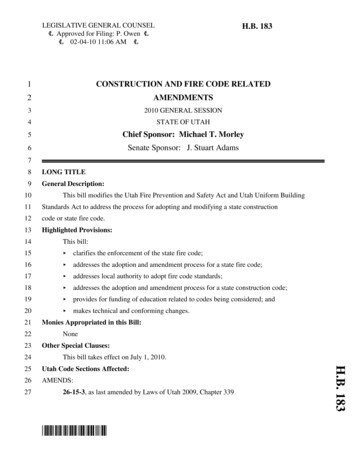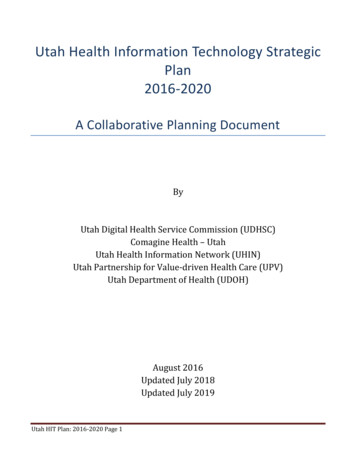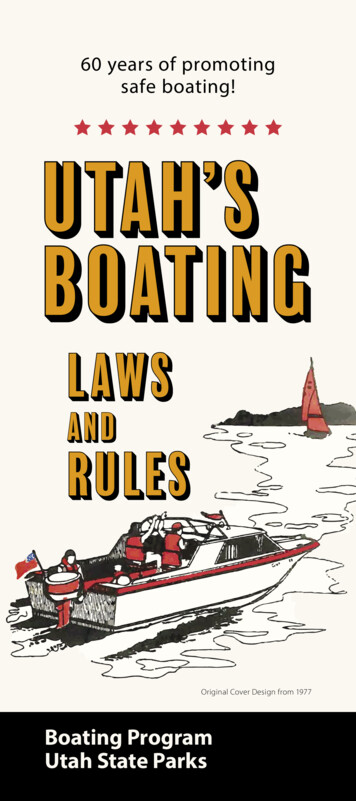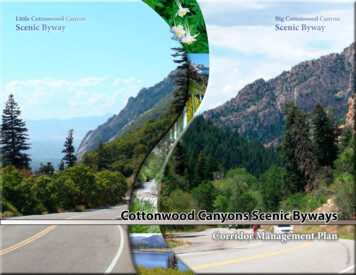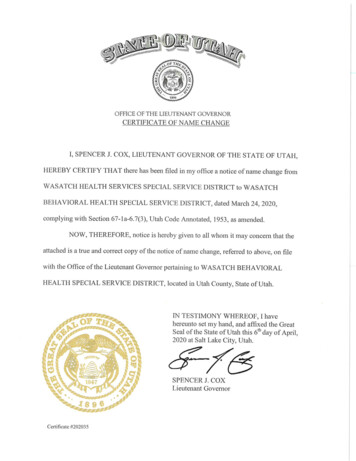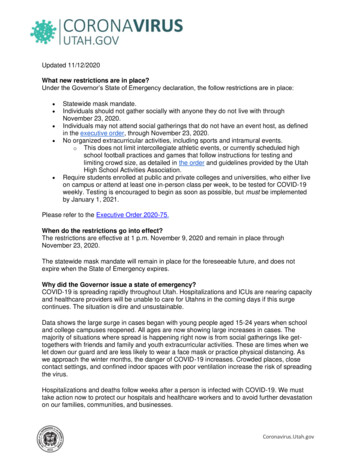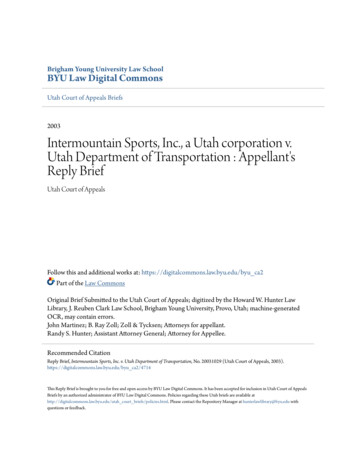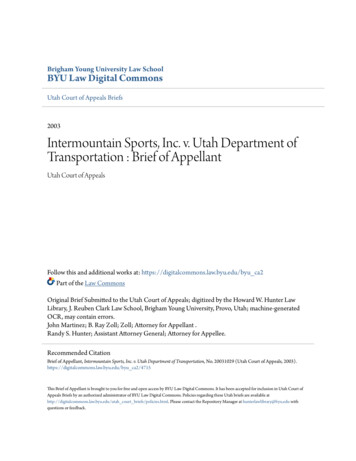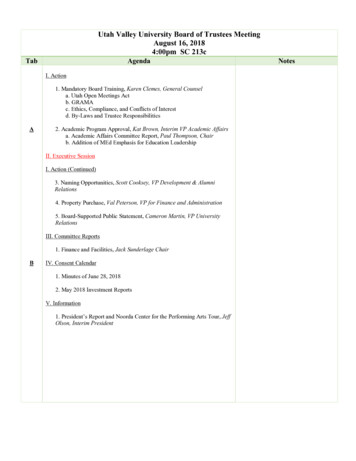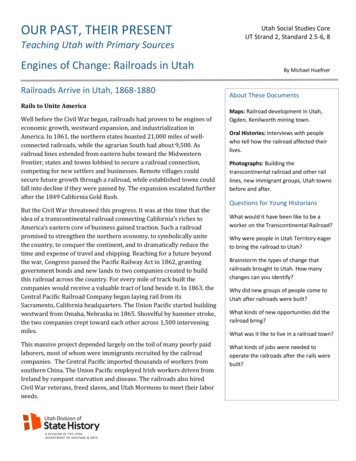
Transcription
OUR PAST, THEIR PRESENTTeaching Utah with Primary SourcesEngines of Change: Railroads in UtahRailroads Arrive in Utah, 1868-1880Rails to Unite AmericaWell before the Civil War began, railroads had proven to be engines ofeconomic growth, westward expansion, and industrialization inAmerica. In 1861, the northern states boasted 21,000 miles of wellconnected railroads, while the agrarian South had about 9,500. Asrailroad lines extended from eastern hubs toward the Midwesternfrontier, states and towns lobbied to secure a railroad connection,competing for new settlers and businesses. Remote villages couldsecure future growth through a railroad, while established towns couldfall into decline if they were passed by. The expansion escalated furtherafter the 1849 California Gold Rush.But the Civil War threatened this progress. It was at this time that theidea of a transcontinental railroad connecting California’s riches toAmerica’s eastern core of business gained traction. Such a railroadpromised to strengthen the northern economy, to symbolically unitethe country, to conquer the continent, and to dramatically reduce thetime and expense of travel and shipping. Reaching for a future beyondthe war, Congress passed the Pacific Railway Act in 1862, grantinggovernment bonds and new lands to two companies created to buildthis railroad across the country. For every mile of track built thecompanies would receive a valuable tract of land beside it. In 1863, theCentral Pacific Railroad Company began laying rail from itsSacramento, California headquarters. The Union Pacific started buildingwestward from Omaha, Nebraska in 1865. Shovelful by hammer stroke,the two companies crept toward each other across 1,500 interveningmiles.This massive project depended largely on the toil of many poorly paidlaborers, most of whom were immigrants recruited by the railroadcompanies. The Central Pacific imported thousands of workers fromsouthern China. The Union Pacific employed Irish workers driven fromIreland by rampant starvation and disease. The railroads also hiredCivil War veterans, freed slaves, and Utah Mormons to meet their laborneeds.Utah Social Studies CoreUT Strand 2, Standard 2.5-6, 8By Michael HuefnerAbout These DocumentsMaps: Railroad development in Utah,Ogden, Kenilworth mining town.Oral Histories: Interviews with peoplewho tell how the railroad affected theirlives.Photographs: Building thetranscontinental railroad and other raillines, new immigrant groups, Utah townsbefore and after.Questions for Young HistoriansWhat would it have been like to be aworker on the Transcontinental Railroad?Why were people in Utah Territory eagerto bring the railroad to Utah?Brainstorm the types of change thatrailroads brought to Utah. How manychanges can you identify?Why did new groups of people come toUtah after railroads were built?What kinds of new opportunities did therailroad bring?What was it like to live in a railroad town?What kinds of jobs were needed tooperate the railroads after the rails werebuilt?
OUR PAST, THEIR PRESENTEngines of Change: Railroads in UtahOnce they arrived in America, both Chinese and Irish immigrantsgenerally suffered from intense racism, and this would hold true onthe railroad. For example, the Central Pacific paid Chinese workersjust 30 a month, about half of what a “white” laborer could expect toreceive. Chinese railroad workers had to build and tunnel through theSierra Nevada Mountains, without question the most difficult terrainalong the transcontinental route. To do this they had no more thanpicks, shovels, and unstable explosives. The Chinese gained areputation as tenacious, skilled workers. While the Central Pacificadvanced slowly through the mountains, the Union Pacific was able tobuild quickly across the plains. But workers on the Union Pacific linefaced their own challenges. Irish immigrant laborers lived on thefringes of society, hated and underpaid because of their Catholicreligion and poverty. Union Pacific workers also built directlythrough Native American bison-hunting territory. They faced attacksfrom Cheyenne and other tribes who were determined to protecttheir homelands, food sources, and way of life from the railroad andthe expansion of American forces across the plains. Railroadcompanies, white settlers, and federal soldiers slaughtered bison bythe thousands, in part to undermine Native American food economiesand weaken Indian resistanceEast and West Meet at Promontory, UtahIn May 1869, immigrant workers from both rail companies set thestage for the final joining of the transcontinental railroad. A team ofIrish workers from Union Pacific on the one hand and a team ofChinese workers for Central Pacific on the other lined up the finalrails and support timbers. Officials from both companies gavespeeches and drove in four ceremonial railroad spikes to completethe seven-year effort. One golden spike was commissioned by arelative of California Governor Leland Stanford, a second golden spikewas given by the San Franscisco Newsletter, a gold- and silverembossed iron spike came from Arizona, and a solid silver spikerepresented Nevada. Although Chinese workers are absent from thephotographs taken during the day’s celebrations, the San FranciscoNewsletter reported that Central Pacific foreman J. H. Strobridgewelcomed a group of Chinese workers from Victory Camp to hisprivate car. “All the guests and officers present cheered them as thechosen representatives of the race which have greatly helped to buildthe road a tribute they well deserved.” (San Francisco Newsletter,May 15, 1869.)Further ExplorationLeonard Arrington, “The TranscontinentalRailroad and the Development of theWest,” Utah Historical Quarterly 39, no. 1(Winter 1969): 3-15.Doris Dant, “Bridge: A RailroadingCommunity on the Great Salt Lake,” UHQ53, no. 1 (1985): 55-73.Richard Francaviglia, “'Rather a CuriousOne': Remembering Utah’s Sanpete ValleyRailway," UHQ 71, no. 1 (2003): 52-68.Rebecca Phillips Guevara, “Boxcars andSection Houses,” Beehive History 6 (1980):10-12.Michael Johnson, "Rendezvous atPromontory: A New Look at the GoldenSpike Ceremony," UHQ 72, no. 1 (2004): 4768.Michael Lansing, "Race, Space, and ChineseLife in Late-Nineteenth-Century Salt LakeCity," UHQ 72, no. 3 (2004): 219-238.Brigham D. Madsen, “Frolics and FreeSchools for the Young Gentiles of Corinne,”UHQ 48, no. 3 (Summer 1980): 220-233.Christopher W. Merritt, "Wooden Beds ForWooden Heads: Railroad Tie Cutting in theUinta Mountains, 1867-1938," UHQ 84, no.2 (2016): 103-117.Robert S. Mikkelsen, “Growing Up Railroad:Remembering Echo City,” UHQ 62, no. 4(1994): 349-362.Utah Historical Quarterly, Railroads andTransportation Special Issue: UHQ 85, no. 4(2017).Page 2
OUR PAST, THEIR PRESENTEngines of Change: Railroads in UtahUtah: Disputed TerritoryAs the two tracks neared Utah in the late-1860s, they did sofollowing a hot period of conflict between Mormons and the federalgovernment in the 1850s. Violently forced from their homes in theMidwest, in 1847 Mormon settlers had fled to Utah, in what wasthen Mexico. They arrived in a region already populated byShoshone, Goshute, Paiute, Ute, and Navajo peoples, andrepresented the first wave of Euro-American settlers who hoped tocolonize the territory. Soon after the Mormons arrived in Salt LakeCity, however, the Mexican Cession of 1848 brought Utah underAmerican rule. Although Mormon leader Brigham Young applied forstatehood, Utah was admitted to the Union as a territory. Thisallowed the federal government to appoint territorial leaders tokeep an eye on this unconventional group.Places to VisitGolden Spike National Monumenthttps://www.nps.gov/gosp/index.htmOgden Union Station, Utah State RailroadMuseum, http://theunionstation.org/Western Mining and Railroad Museum,Helper, http://www.wmrrm.comAt the time, many Americans were suspicious of Mormons because of their devotion to their leaders and practice ofpolygamy. Mormons for their part did little to cooperate with the first federally appointed leaders, looking insteadto Brigham Young in most matters. The first several government appointees resigned their positions in frustration.Other misunderstandings followed, and tensions remained high. In 1857, war was narrowly avoided when the U.S.Army was sent to put down a falsely reported Mormon rebellion. Later that year, an armed posse of Mormonskilled a party of overland emigrants from Arkansas as they crossed southern Utah. The Mountain MeadowsMassacre remains the darkest moment in this chapter of Mormon relations with the outside world. In general,most Mormons distrusted outsiders because of the persecution they had experienced, while federal officials andothers remained suspicious of the Mormons’ polygamy and political unity.As the railroads converged on Utah in 1869, 91 percent of the Euro-Americans who had settled here since 1847were Mormons. But the railroad would soon bring a varied host of newcomers to Utah’s doorstep. As much as theMormons had hoped to build a new Zion in Utah based on their distinctive religious beliefs, Young understood thatthe railroad would help Mormon immigrants and businesses. When the Union Pacific chose its route throughWeber Canyon, Young offered the company land for station buildings in Ogden. Mormon leaders promoted Ogden’ssuccess so that it might beat out the next town on the line, non-Mormon Corinne. The cultural competitivenessbetween Corinne, Salt Lake, and Ogden gained economic importance as the railroads arrived.The Railroads Spread, 1880-1920sWithin eight months after the transcontinental railroad was completed, rails had connected Ogden and Salt LakeCity and Utah’s relative isolation was no more. The Salt Lake line tapped into nearby mining districts such as Altaand Park City, and mining production grew sevenfold in 1870 alone. Railroad companies employed many laborers,who laid and repaired track, and worked as security guards, baggage handlers, and other jobs. Many more people’swork became closely tied to the railroad, as well, since it allowed Utahns to gain much easier access to marketsfrom California to the East. From 1865 to 1890, American rail companies built over 70,000 miles of track west ofthe Mississippi River, a growing trade network in which Utah occupied an important place. Salt Lake City andOgden attracted tradespeople and new businesses. Because Mormon immigrants and others traveling west couldnow cross the plains more cheaply, the rate of settlement increased. Farmers prospered as their crops could nowPage 3
OUR PAST, THEIR PRESENTEngines of Change: Railroads in Utahbe more quickly transported to buyers within and beyond Utah. Utah consumers rejoiced as products from outsideUtah, such as clothing, were now available at lower prices. Utah cities built streetcar lines and electric railroads toimprove public transportation within and between cities, even to the fashionable Saltair Resort.Ogden and Corinne: Two Railroad TownsWhen the transcontinental railroad crossed through northern Utah, it spurred the hopes of many towns, but twothat were greatly affected were Ogden and Corinne.Ogden began as a small Mormon farm town, but after the Union Pacific arrived Ogden began to grow. Travelers inthe 1870s would have seen small, hastily built buildings near the railroad stations including restaurants, taverns,and gambling houses. Beyond this remained a fairly quiet town that supplied most of its own needs through smallshops, gristmills, and surrounding farms. Ogden’s fortunes changed again in 1874, when the Union Pacific andCentral Pacific made it the junction where passengers and freight were transferred between the two lines. Ogden’spopulation surged from 3,000 in 1870 to more than 12,000 in 1890. A large new rail depot was completed in 1889,the same year the town elected its first non-Mormon mayor.Corinne was also an important place of trade in 1870. Lying at the connection of the Bear River and the railroadline, Corinne’s overland freight trade carried goods and ores between Montana mines and the transcontinentalrailroad. Chinese railroad workers settled there and established businesses, such as laundries and restaurants.Two dance halls and three churches were built, including the 1870 Methodist-Episcopal Church, the oldestProtestant church in the state. The railroad brought many tourists and curious observers, and Corinne’s reputationfor excitement brought people from neighboring towns to dances, sporting events, and dramatic performances atthe opera house. Corinne’s non-Mormon founders hoped it would become the cultural and economic center ofUtah.But during the 1870s a new rail line allowed Ogden to cut into Corinne’s freight business. The Utah NorthernRailroad, reaching north from Brigham City to Franklin, Idaho, soon absorbed Corinne’s lucrative Montana trade.By the decade’s end most of the jobs and people in Corinne had left seeking better opportunities.The Lucin CutoffIn 1904 Corinne’s fate was sealed when the Southern Pacific Railroad (formerly the Central Pacific) completed theLucin Cutoff. This bypassed the old Transcontinental route from the West Desert to Ogden by carrying trainsdirectly across the Great Salt Lake. This ambitious project built a trestle system across twelve miles of open water.The trestles “were constructed by establishing stations at each mile end of the route and setting two pile-drivers towork back to back. The workmen were quartered right on the site ‘well out of the way of storm-waves’ in aboarding house resting on a platform supported by piles. For this privilege the men paid four dollars a week each,but supplies and cooks were free,” (Dant). Work crews lived away from many comforts and without days off. Thelake’s extremely salty water was so heavy (seventy-six pounds per cubic foot) that storm waves could damage thetrestle and move the massive boulders supporting it.After the Lucin Cutoff opened, the railroad completely bypassed Corinne, and without this economic pillar the townwithered.Page 4
OUR PAST, THEIR PRESENTEngines of Change: Railroads in UtahRails and Mines Grow Hand in HandColonel Patrick Connor, commander of the U.S. Army’s Camp [Fort] Douglas above Salt Lake City, played a criticalrole in the growth of Utah’s railroads. Connor’s official job was to keep mail routes safe, but he harbored strongconcerns about the Mormons’ monopoly over goods and resources in Utah. To counter this, Connor worked topromote immigration. Connor saw the discovery of valuable minerals as the key to this plan, so he sent prospectorsthroughout the territory. When they found gold, silver, and other useful minerals it took the mining industry inUtah to new heights. This in turn fueled the spread of railroads and, as Connor hoped, brought thousands ofethnically and religiously diverse immigrants to Utah.The Union Pacific and Southern Pacific continued to build rails across the state in the 1870s, especially into themining districts. In the 1880s the Denver & Rio Grande (D&RG) Railroad connected the coal district of Price,Helper, Kenilworth, and Castle Gate to the string of settlements along the Wasatch Mountains. Thanks to the D&RGcoal mining became an economic mainstay in Utah. These coal-mining towns expanded quickly, and Carbon Countywas organized in 1894. Like most mining areas in Utah Carbon County attracted a diverse population of workersand their families, especially from Italy, Greece, Finland, and Great Britain. As industry increased immigrationcontinued, bringing a kaleidoscope of cultures to mining towns like Kenilworth across the state.Many Americans might not have felt the impact of the transcontinental railroad immediately, but Utahns quicklyexperienced the changes. From a desert outpost to a crossroads, a Native homeland to a conglomeration of newsettlements, the railroads set Utah’s evolution toward modernity in motion. Well into the 1950s, railroads wouldremain the best mode for interstate passenger travel as well as freight. Even in the 21st century, trains play acritical role in Utah’s industrial economy.Utah Territory Settler Population: Changing Religious & Ethnic DemographicsYear18601869Settler PopulationMormons40,273Other Religious/Ethnic Groups92%8%Transcontinental Railroad Completed May 10, %34%Data from the U.S. Census, May, Utah: A People’s History, p. 116, and Alexander, Utah: The Right Place, p. 140.Page 5
OUR PAST, THEIR PRESENTEngines of Change: Railroads in UtahSourcesAlexander, Thomas G. Utah, The Right Place: The Official Centennial History, SLC: Gibbs Smith, 1995.Arrington, Leonard. “The Transcontinental Railroad and the Development of the West,” Utah Historical Quarterly39, no. 1 (Winter 1969): 3-15. https://collections.lib.utah.edu/details?id 421779“Chinese American Contribution to Transcontinental Railroad,” Central Pacific Railroad Photographic HistoryMuseum, June 2017. http://cprr.org/Museum/Chinese.htmlDant, Doris R. “Bridge: A Railroading Community on the Great Salt Lake,” Utah Historical Quarterly 53, no. 1 (1985):56-59. https://collections.lib.utah.edu/details?id 423033.Fisher, Jennifer, et al., “Building the First Transcontinental Railroad,” Digital Public Library of America, May continental-railroadMadsen, Brigham D. “Frolics and Free Schools for the Young Gentiles of Corinne,” Utah Historical Quarterly 48, no. 3(Summer 1980): 220-233. 84/view/1May, Dean. Utah: A People’s History, Salt Lake City: University of Utah Press, 1987.Olsen, Jalynn. Building by the Railyard: The Historic Commercial and Industrial Architecture of Ogden, Utah(Graduate School of Architecture, University of Utah, 1998).https://collections.lib.utah.edu/details?id 418969Phippen, J. Weston. “‘Kill Every Buffalo You Can! Every Buffalo Dead Is An Indian Gone,’” The Atlantic, May 13,2016. 05/the-buffalo-killers/482349/Strack, Don. “Railroads in Utah,” Utah History to Go, 1994.http://historytogo.utah.gov/utah chapters/mining and railroads/railroadsinutah.html“The Civil War: Facts,” NPS.gov. ” Chinese Railroad Workers in North America Project at Stanford ilroad/cgi-bin/wordpress/timeline/#fn33Page 6
OUR PAST, THEIR PRESENTEngines of Change: Railroads in UtahSTUDENT READING – Engines of Change: Railroads in UtahAfter seven long years of laying track, the nation completed its first transcontinental railroad at PromontorySummit, Utah, on May 10, 1869. Before its completion, the stage coach ride from Chicago to San Francisco tookalmost a month. After 1869, people and goods could make the trip in 5 ½ days. In the following years, railroadexpansion was especially important for towns along a line’s path. A town connected to a railroad could flourish; abypassed town risked decline. Utah had been a very isolated state, but the railroad brought businesses and peoplefrom all over the globe.The transcontinental railroad launched Utah’s railroad age. Eight months after the transcontinental railroad’scompletion, new rail lines connected Ogden to Salt Lake City. From there, lines connected Salt Lake City to miningareas like Alta and Park City. Mining became a major industry in the state. New rail lines to places like Price,Helper, and Castle Gate helped mining districts grow. Many other jobs became tied to the railroad as well. Laborersoften laid and repaired track, worked as security guards, or handled baggage. The railroad made it easier and fasterto ship goods, which allowed farmers to sell their crops to more distant markets without spoiling. Trade grewthroughout the state and attracted more people and new businesses.Utah’s growth attracted thousands of immigrants and their families. Before 1869, 91 percent of Euro-Americans inUtah were members of the Church of Jesus Christ of Latter Day Saints (Mormons). However, after the arrival of therailroads, the population began to shift. By 1890, Mormons made up 66 percent of Utah’s population. Manyimmigrants came from European countries like Italy, Greece, Finland, and Great Britain. Some came in hopes offinding mineral wealth in Utah’s mining areas. Others saw Utah as a good place to practice trades they had learnedin Europe. Immigrant settlers came from many different ethnic and religious backgrounds and made Utah a morediverse place.The story of Ogden and Corinne show how the railroad could make or break a town. Both were along the railroad’spath and rivaled each other for growth. Railroad stations became home to restaurants, taverns, and places forentertainment. These attractions brought many visitors and settlers. But in the 1870s, a new rail line – the UtahNorthern Railroad – diverted cargo bound for Montana away from Corinne, undermining Corinne’s freight trade.Then in 1904, the Lucin Cutoff allowed trains to travel directly across the Great Salt Lake rather than around itsnorthern tip. The new route was quicker, but it completely bypassed Corinne. As a result, the town shrank as itseconomy declined. Most of the people left Corinne seeking better opportunities.The transcontinental railroad completely changed Utah’s population and landscape. What was once a desertoutpost became a crossroads for the continent. The mining industry created settlements along the WasatchMountains and attracted large populations of immigrants. The railroad continued to be an important mode oftransportation well into the 1950s until cars took its place. However, even with large trucks and airplanes, trainscontinue to play a crucial role in Utah’s industrial economy.Page 7
OUR PAST, THEIR PRESENTEngines of Change: Railroads in UtahMAP SERIES: Railroads Spread Through Utah, 1869-1920Page 8
OUR PAST, THEIR PRESENTEngines of Change: Railroads in UtahPage 9
OUR PAST, THEIR PRESENTEngines of Change: Railroads in UtahPage 10
OUR PAST, THEIR PRESENTEngines of Change: Railroads in UtahOral History: William G. Smith (1938)Source: Utah Division of State History, Works Progress Administration Biography Sketches Collection, MSS B 289, p. 16-17.https://collections.lib.utah.edu/details?id 697535Smith’s family emigrated to the U.S. from England and settled in Huntsville, Utah. As a young man he worked for both theUnion Pacific and Central Pacific to help build the first transcontinental line. His later work took him through Ogden andCorinne regularly. Define: apostle, board, cut, freight.“Later that year, 1863, we moved to Huntsville. I knew old Captain Hunt, who settled it. I worked on the Union PacificRailroad when it was being built from Echo to Ogden in 1868 and 1869. When the grade had reached Peterson, ApostleFranklin D. Richards took a contract to move the wagon road from down in the river bottom to the side of the hill abovethe tracks. He hired me for 5 a day and board for myself and yoke of oxen. We cut the road on the hillside and he waspaid so much a cubic yard for removing the earth. Then we piled the earth on the grade for the railroad, and he was paidso much a yard for the fill, and thus made money both ways.When the road progressed as far as Promontory station, Benson, Farr, and West, a firm of contractors, had a hundredmile contract on the Central Pacific building east. Just about a mile west of where the golden spike was driven they hadto make a cut of about a mile. This was heavy work and they were afraid they could not finish on time, so they sent wordto Ogden to secure as many men as possible. Jack Wilson, Henry Bronson, and myself went out with yokes of oxen andhelped them finish that cut. They paid us 2.50 a day and board. We did most of the work with wheelbarrows as thatwas before the day of the steamshovels .Then [Calvin] Wheeler hired me to help him drive 300 head of cattle from Promontory to Ogden. He used to get 3 ahead for taking care of cattle all winter for people who did not want to herd their own. I helped him bring the cattle injust before the last spike was driven so I missed seeing the golden spike celebration.In 1870 I hauled freight to Pioche, Nevada, where the mines had opened up. Then in 1871 I went to freighting toMontana. Great herds of buffalo blackened the Sun River prairies at that time and we often killed one for meat. I neverbelieved in slaughtering more than we could use. We would pick out a young buffalo with a black color because they getbrowner as they get old. The meat is excellent. I always enjoyed the tender chops off the hump of the bison. We wouldroast them over the hot coals by putting sharp green sticks in the ground to hold the chunks of meat near the fire.Sometimes we fried the meat or cooked it in Dutch ovens in the ashes. I had two men with me and we drove two tenmule teams. We often shot a deer and would cook the entire hindquarters for a meal.It used to take us twenty-one days to drive from Corinne, Utah to Helena, Montana . I used to haul freight for amerchant named Kleinsmid. We got 5 a pound for heavy stuff, 7½ for dry goods, and 10 for millinery, because thatwas light and took up a lot of space in the wagons. We could put 3,000 pounds in a wagon, the trail and swing wagons,and 7,000 pounds on the lead wagons when we had three hooked up in a line. There were a lot of cutthroats androbbers in Helena in the early days.”Page 11
OUR PAST, THEIR PRESENTEngines of Change: Railroads in UtahOral History: Isabella Wade Allred (1940)Source: Utah Division of State History, Works Progress Administration Biography Sketches Collection, MSS B 289, Box 1, Folder14, p. 4-6. https://collections.lib.utah.edu/details?id 700797When Allred was a girl her father worked for Union Pacific. They lived on the plains of Nebraska near Omaha, before movingwest to Utah. Define: handcar, calico, government mules.“The old engines on the railroad had real large smokestacks because they were wood-burners and burned cedar wood.Mother did all her buying in Omaha and I always went along with her. Little towns along the way would probably benothing but water tanks and a pile of cedar wood alongside with which to refuel the engine. The sparks from the trainsoften set fire to the grass growing along the tracks, and these prairie fires would send the buffalo running to get out ofthe burning grass. A large tract of the ground around our home was plowed up to protect us from the fires.When mother purchased flour or sugar or syrup, they came in barrels, and the tea was purchased in 50-pound cans. Theinside of the cans were lined with lead paper. I used to make doll dresses and things out of the paper. Even after wemoved to Utah, father would buy tea in these large cans or caddies. Many of our neighbors in Utah would come overand mother often gave them some of the tea to take home with them.Father often rode on one of those handcars that were pictured in the motion picture Union Pacific. It brought therecollections back to my mind so vividly. The buffalo didn’t browse near the handcars as shown on the screen though;they were much too wild for that. But I have seen many herds of buffalo. Father and some of the section men very oftenwould shoot a buffalo or some wild animal. When we came to Utah we brought five buffalo skins with us.If a train went by with soldiers on it, I would hear my brother or father remark that the Indians must be on the warpathor there was trouble somewhere along the way, because Uncle Sam was out in full force. They were never referred to assoldiers but always as Uncle Sam. There would be three cars of them with the flag held high by those in the front car.They were a pretty sight in their uniforms and with their rifles and bayonets shining in the sun.In the picture Union Pacific, it showed one place where the Indians tore up the tracks and set fire to the railroad. I haveoften heard my father tell of that, so it really did happen. He said how the Indians rode by with yards and yards of calicoflying behind them. They wrecked the train by tearing up the ties and burning them, and then they upset the flour andsugar barrels and scattered foodstuffs everywhere. They took the bolts of materials and fastened them to their horsesand dragged it along behind them as they rode by. They decked themselves up with any of the clothing they found.Father brought some of the sugar and flour home with him when he came back after investigating.In 1868 father decided to quit the railroad and come to Utah. We went into Denver and there he bought a new wagon, aspan of government mules, and a bay mare, and we came to Salt Lake City.”Page 12
OUR PAST, THEIR PRESENTEngines of Change: Railroads in UtahPhoto: Railroad workers curving iron rails, 12-Mile Canyon, Nevada, 1868Source: “Central Pacific R.R. – Construction P. 16,” by Alfred A. Hart, official Central Pacific Railroad photographer, Utah StateHistorical Society Classified Photo Collection. https://collections.lib.utah.edu/details?id 455316This process used the weight of six men standing on the side of a rail, while another struck it with a heavy hammer, togradually curve the metal.Page 13
OUR PAST, THEIR PRESENTEngines of Change: Railroads in UtahPhoto: Central Pacific Workers and Officials at Victory Camp, Utah, 1869Source: ”Central Pacific Railroad – Construction, P. 2,” 1869, Utah State Historical Society Classified Photo s?id 454934This photo shows Central Pacific workers at Victory Camp, Utah. These workers had just finished laying 10 miles of rail in 12hours. This feat won a bet for Central Pacific’s president, who wagered 10,000 with the Union Pacific president that hisworkers could build more in one day. Look closely at the photo. Where do you think all the wood came from? What do you think is in the crates? Whatmight the white buildings be for? How about t
Teaching Utah with Primary Sources Engines of Change: Railroads in Utah. Utah Social Studies Core UT Strand 2, Standard 2.5-6, 8 . By Michael Huefner . Railroads Arrive in Utah, 1868-1880. Rails to Unite America . Well before the Civil War began , railroads had proven to be engines of economic growth, westward expansion, and industrialization .

